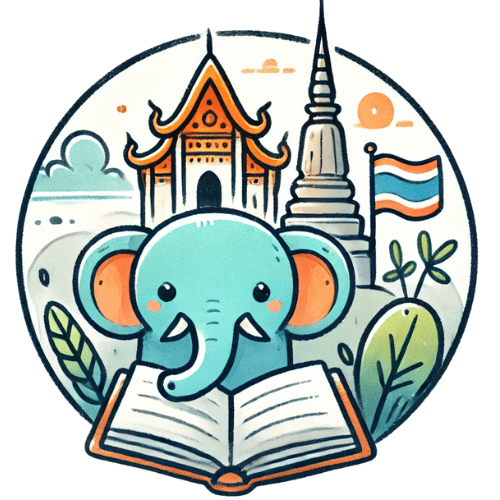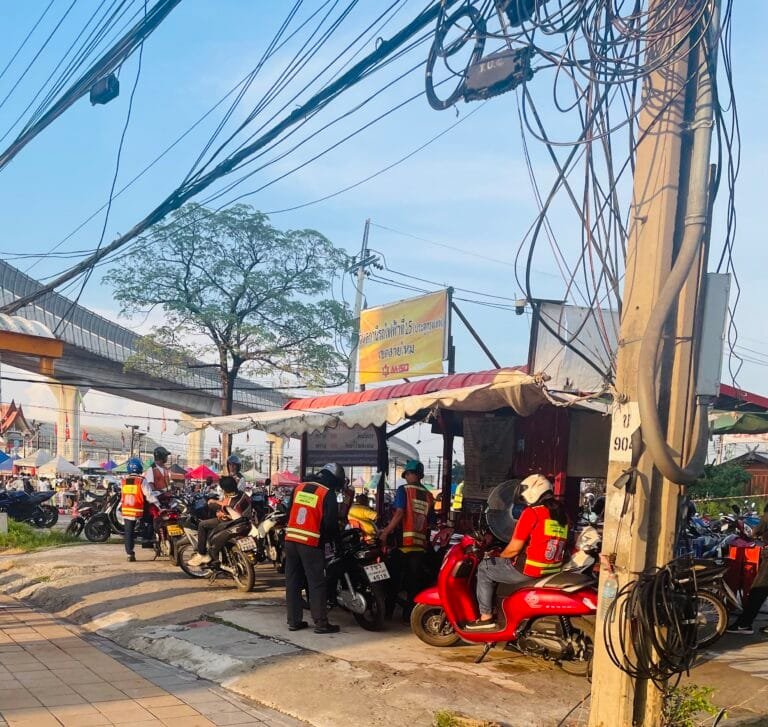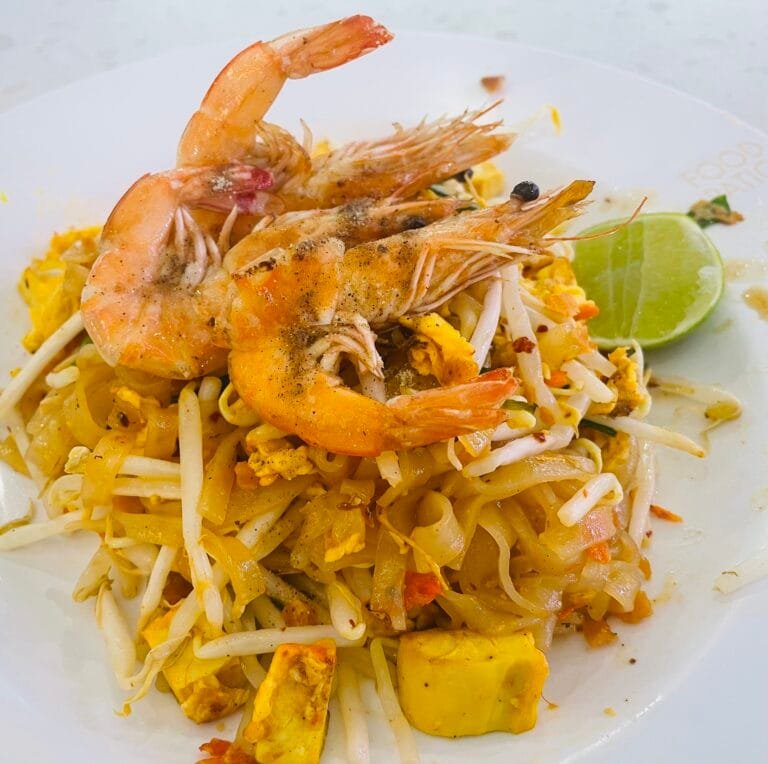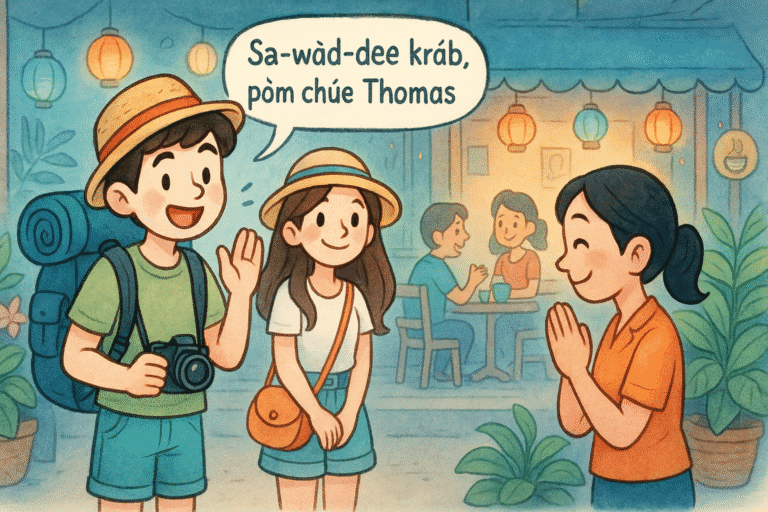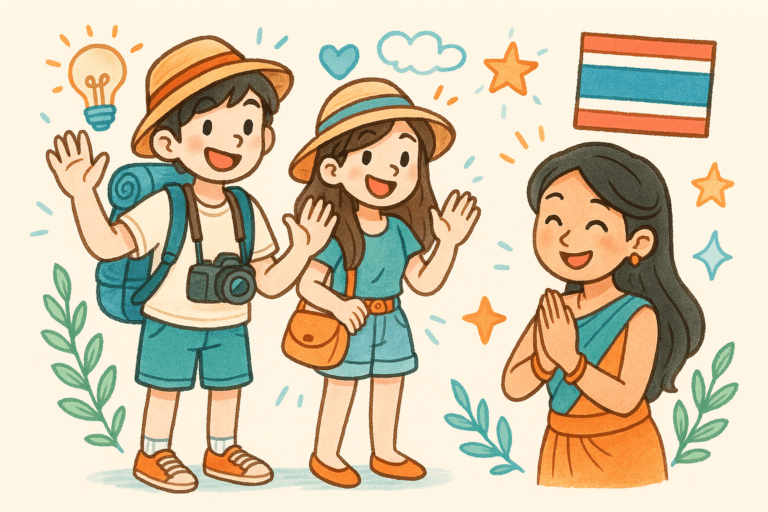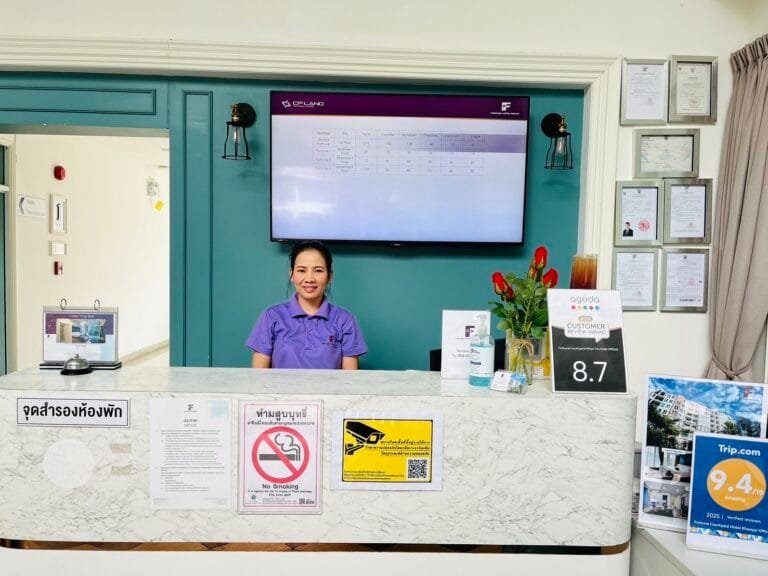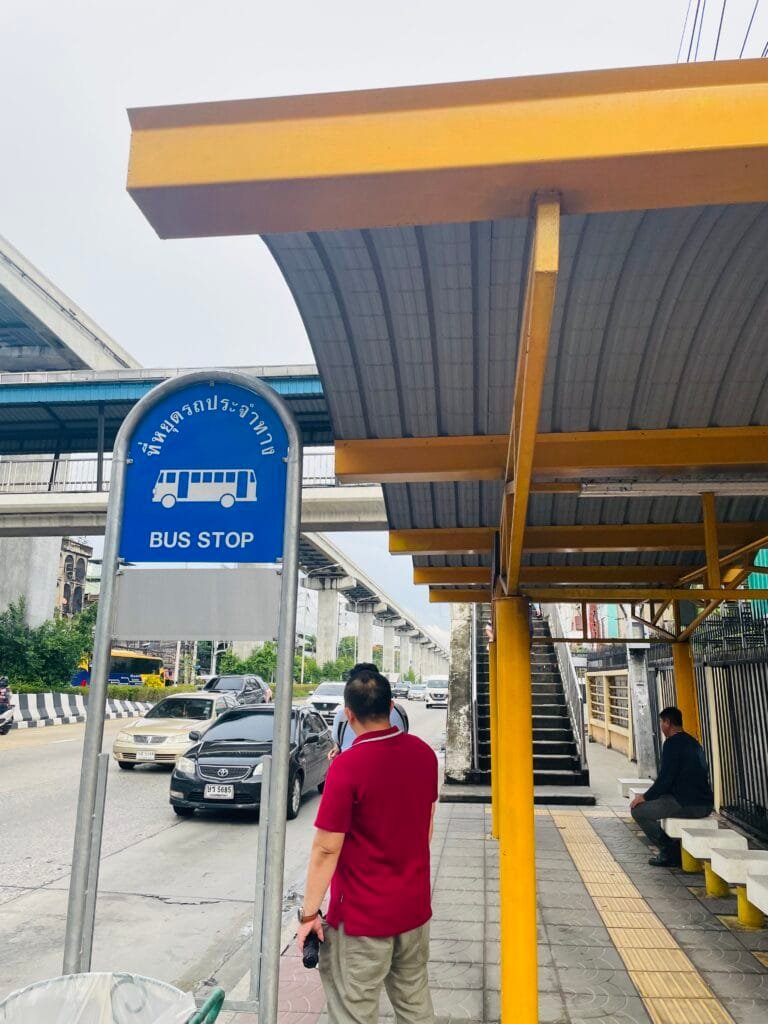Ordering Coffee in Thai

Welcome to Essential Thai for Coffee Lovers! In this lesson, you’ll master ordering coffee in Thai while exploring Thailand’s vibrant café culture. Whether you’re at a local street cart or a modern café, you’ll learn the key phrases and cultural tips to enjoy your cup of coffee like a local. Let’s begin your Thai language journey!
Ordering Coffee in Thai: Essential Vocabulary
Before diving into ordering your favorite coffee drinks in Thai, let’s master the essential vocabulary that every traveler needs to know. This beginner-friendly guide will teach you common Thai words and phrases used in cafés across Thailand. Perfect for tourists and language learners, these basic Thai expressions will help you confidently order anything from a traditional Thai iced coffee to a modern cappuccino. Ready to impress baristas with your Thai language skills? Let’s start with the fundamentals!
Drinking Types:
- coffee (กาแฟ = gaa fae)
- Thai tea (ชาไทย = cha thai)
- green tea (ชาเขียว = cha kĭew)
- lemon tea (ชามะนาว = cha ma now)
- hot chocolate (ช็อคโกแลตร้อน = chóg goo láed-róon)
- Italian soda (อิตาเลี่ยนโซดา = Italîan soda)
- Fruit smoothie (สมูทตี้ = Smúud dtêe)
- hot (ร้อน = róon)
- iced/cold (เย็น = yen)
- large cup (แก้วใหญ่ = gâew yài)
- small cup (แก้วเล็ก = gâew lég)
Sweetness Levels:
- not sweet (ไม่หวาน = mâi wăan)
- no sugar (ไม่ใส่น้ำตาล = mâi sài náam dtaan)
- a little sweet (หวานน้อย = wăan nóoy)
- normal sweet (หวานปกติ = wăan bpà gà dtì)
- very sweet (หวานมาก = wăan mâag)
Milk Options:
- milk (นม = nom)
- fresh milk (นมสด = nom sòd)
- condensed milk (นมข้นหวาน = nom kôn wăan)
- no milk (ไม่ใส่นม = mâi sài nom)
- soy milk (นมถั่วเหลือง = nom tùa lŭeang)
- almond milk (นมอัลมอนด์ = nom ao-môn)
- oat milk (นมโอ๊ต = nom oád)

Numbers in Thai: 1-5
Ready to count in Thai? Let’s get started with the most frequently used numbers you’ll need at any Thai café!
one (หนึ่ง = nùeng)
two (สอง = sŏorng)
three (สาม = săam)
four (สี่ = sèe)
five (ห้า = hâa)
Essential Thai Common Phrases- Step by Step Ordering Guide
Never feel lost at a Thai café again! This practical guide breaks down the entire coffee-ordering process into simple, manageable steps using essential Thai phrases. Perfect for tourists and language beginners. Whether you’re at a local street cart or a trendy Bangkok café, this step-by-step guide will help you order coffee in Thai with confidence.
- Can I get ……..? (ขอ = kŏr) One cup (หนึ่งแก้ว = nùeng gâew)
- One cappuccino, please. (ขอคาปูชิโน่หนึ่งแก้วค่ะ kŏr cappuccino nùeng gâew kâ/kráb)
- I’m lactose intolerant. (แพ้นมวัว = páe nom wua)
- Can I have soy milk instead?
(ขอเปลี่ยนเป็นนมถั่วเหลืองได้ไหม = kŏr bplìan bpen nom tùa lŭeang dâay mái)
- Thank you (ขอบคุณ = kòorb kun kâ/kráb)
- Take away (เอากลับบ้าน = ao glàb bâan)
- Drink/Eat here (ทานที่นี่ = taan têe nêe)
Step by Step Ordering Guide
1. “One hot coffee please.”
ขอกาแฟร้อนหนึ่งแก้วค่ะ/ครับ kŏr gaa fae róon nèung gâew kâ/kráb
2. “One iced coffee please.”
ขอกาแฟเย็นหนึ่งแก้วค่ะ/ครับ kŏr gaa fae yen nèung gâew kâ/kráb
3. “Iced coffee with little sugar.”
ขอกาแฟเย็นหวานน้อยค่ะ/ครับ kŏr gaa fae yen wăan nóoy kâ/kráb
4. “Hot coffee no sugar.”
ขอกาแฟร้อน ไม่ใส่น้ำตาลค่ะ/ครับ
kŏr gaa fae róon mâi sài náam dtaan kâ/kráb
Sample Conversations: Order Coffee Like a Local!
Let’s put your Thai language skills into action with this authentic coffee shop dialogue! Perfect for tourists and beginners, this practical conversation shows you exactly how locals order their favorite drinks in Thailand.
Barista: Hi, what would you like?
(สวัสดีค่ะ/ครับ sa wàd dee kâ/kráp รับอะไรดีคะ/ครับ ráb arai dee ká/kráp?)
Customer: One hot cappuccino, please.
(ขอคาปูชิโน่ร้อนหนึ่งแก้วค่ะ/ครับ kŏr cappuccino róon nèung gâew kâ/kráb)
Barista: Normal sweet?
(หวานปกติไหมคะ/ครับ (wăan bpà gà dtì mái ká/kráb)
Customer: A little sweet.
หวานน้อยค่ะ/ครับ (wăan nóoy kâ/kráp) Thank you. (ขอบคุณค่ะ/ครับ = kòorb kun kâ/kráb)

Coffee Shop Types in Thailand
Whether you’re craving a classic Thai iced coffee from a local vendor or seeking a specialty brew in a modern café, understanding these distinct coffee shop types will enhance your travel experience. Learn where to find them and what to expect at each venue.
Street Coffee Shops (รถกาแฟ /rod gaa-fae)
– Atmosphere: Casual, often just a cart or small stall with plastic chairs
– Price Range: 25-40 baht
– Common Orders: Thai iced coffee (กาแฟเย็น/gaa fae yen), Hot Thai coffee (กาแฟร้อน/gaa fae róon)
– Vendors often start early morning (5-6 AM)
– Plastic bags for takeaway are common
– Less English is spoken here
– cashless payment option (mobile payments)
Modern Cafés (ร้านกาแฟ ráan gaa fae)
– Atmosphere: Air-conditioned, comfortable seating
– Price Range: 60-180 baht
– Common Orders: Espresso-based drinks, frappuccinos
– Staff usually speak some English
– Credit cards are widely accepted
– Western-style menu available
– Mix of traditional and modern brewing methods
– Light meals available
Mall/Chain Cafés (ร้านกาแฟในห้าง / ráan gaa fae nai hâng)
– Free Wi-Fi and plenty of power outlets
– Price Range: 80-180 baht for Espresso-based drinks, Specialty drinks: 120-200 baht
– English-speaking staff and bilingual menus make ordering easy for tourists
– Modern cashless payment options (credit cards, mobile payments)
– Extended operating hours (usually 10:00 AM – 9:00 PM)
Eco-Friendly Ordering
Want to enjoy Thailand’s amazing coffee culture while being environmentally friendly? Learn these essential Thai phrases to make sustainable choices at any café! Perfect for eco-conscious tourists and language learners, this guide will teach you how to order your coffee with a green twist. From requesting no plastic straws to bringing your own tumbler, discover how to communicate your eco-friendly preferences in Thai.
Most street vendors don’t have recycling options. Convenience culture is still strong in Thailand. Average customer uses 3-4 plastic items per drink: Plastic bags for iced drinks (ถุงกาแฟ/ tŭng gaa fae), Plastic cups (แก้ว /gâew) with dome lids (ฝา/făa), Plastic straws (หลอด / lòrd), Extra plastic bags for carrying (หูหิ้ว/ hŭu hîw). These single-use plastics often end up in landfills or oceans. However, environmental awareness is growing in Thailand. Many younger Thais are becoming more eco-conscious, and some cafés are leading green initiatives. You can be a part of eco-friendly growing culture by bringing your own container. Learn to say “no” to extra plastic items politely. Some shops offer loyalty points or 2-5 Baht discount.
Useful Phrases for Eco-Friendly Ordering
1. “I brought my own cup.” (เอาแก้วมาเอง ao gâew maa eeng)
2. “Please use this cup.” (ขอใส่แก้วนี้ kŏr sái gâew née)
3. “No plastic bag needed.” (ไม่ต้องใส่ถุง mâi dtông sái tŭng)
4. “No straw please.” (ไม่เอาหลอด mâi ao lòrd)
Cultural Tips: Essential Etiquette Guides for Travelers!
Let’s explore the cultural nuances that will make your café experience even more authentic and enjoyable. These valuable insights go beyond just learning Thai phrases – they’ll help you connect with locals and show respect for Thai customs while ordering your favorite drinks.
- Always end sentences with ค่ะ (kâ) if you’re female or ครับ (kráb) if you’re male.
- While the ‘wâay’ (traditional Thai greeting with pressed palms) is an important part of Thai culture, it’s not expected when ordering at cafés or restaurants. A warm smile is perfectly polite and appropriate! Smiling is a big part in communication. Learn to smile in different ways!
- Thai is a tonal language, but Thai People will understand you even if tones aren’t perfect.
- Speak slowly and clearly. Use hand gestures to help communicate.
- At street vendors, wait for your drink to be prepared (usually quick).
- In modern cafés, you’ll often receive a number or buzzer.
- Tipping is not expected but appreciated.
- Modern cafés are more likely to have alternative milk options
- Street vendors might not have non-dairy alternatives
- Some places charge extra for alternative milk (10-20 Baht).
- If you have allergies, it’s best to learn how to communicate them in Thai.
